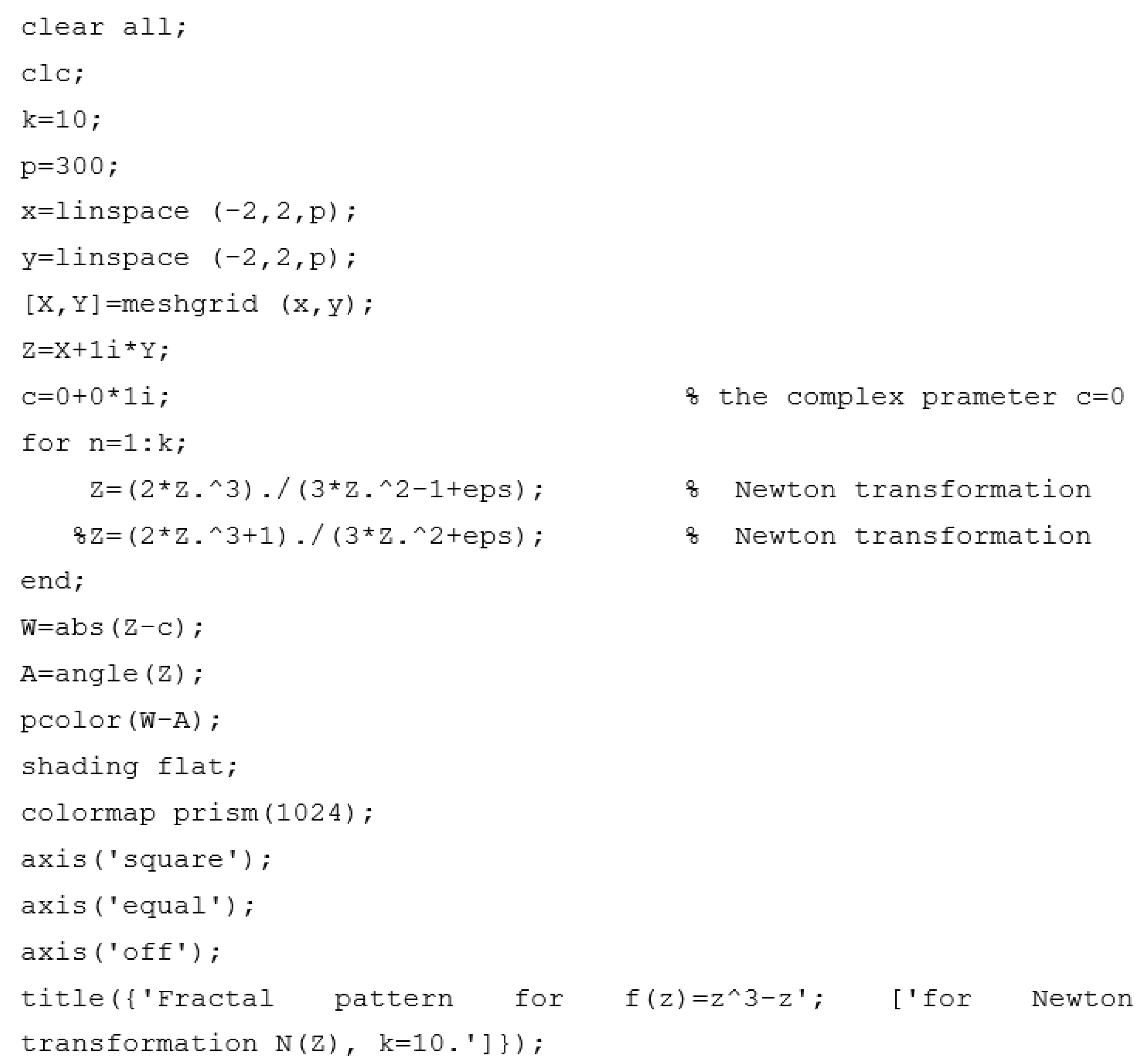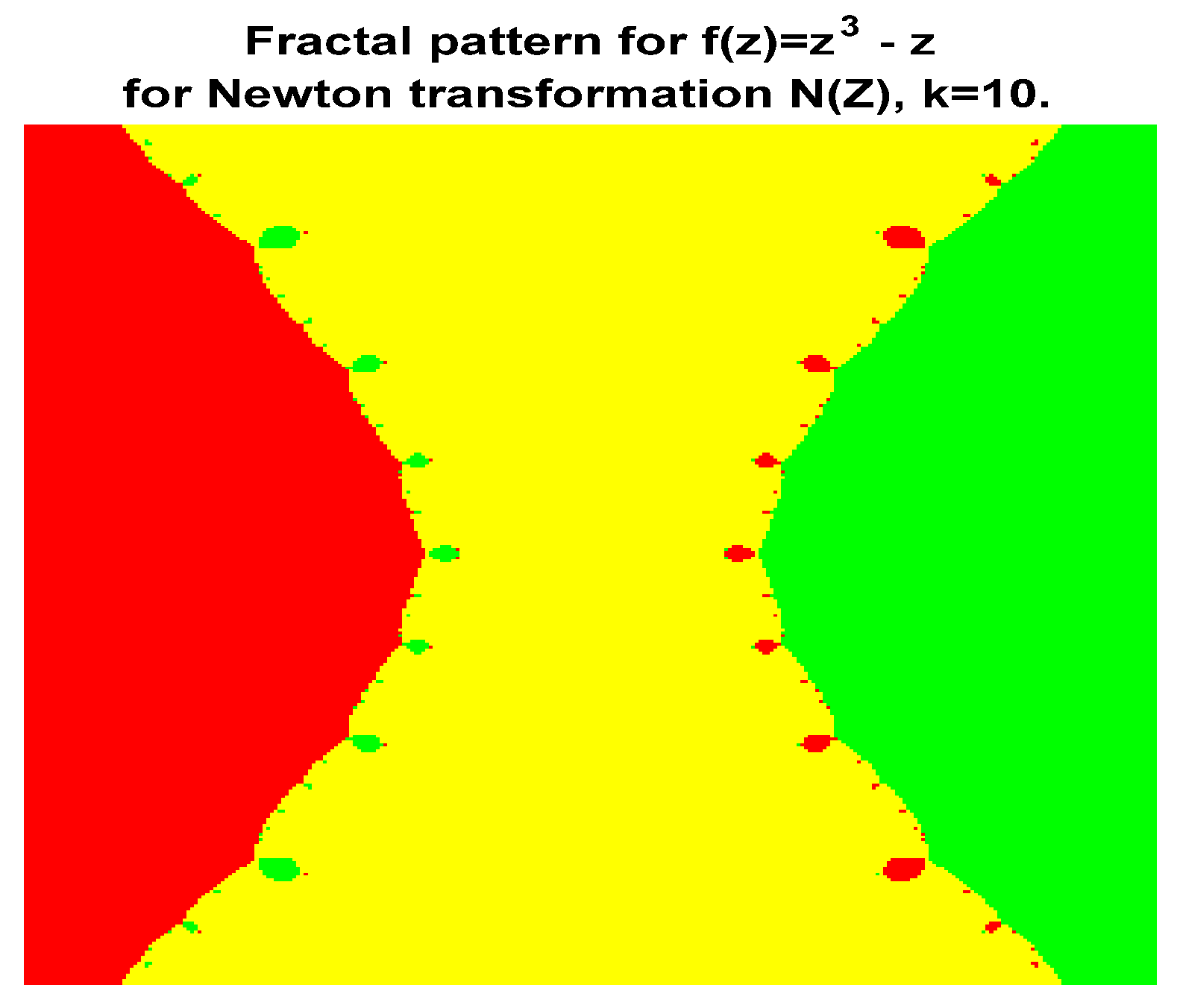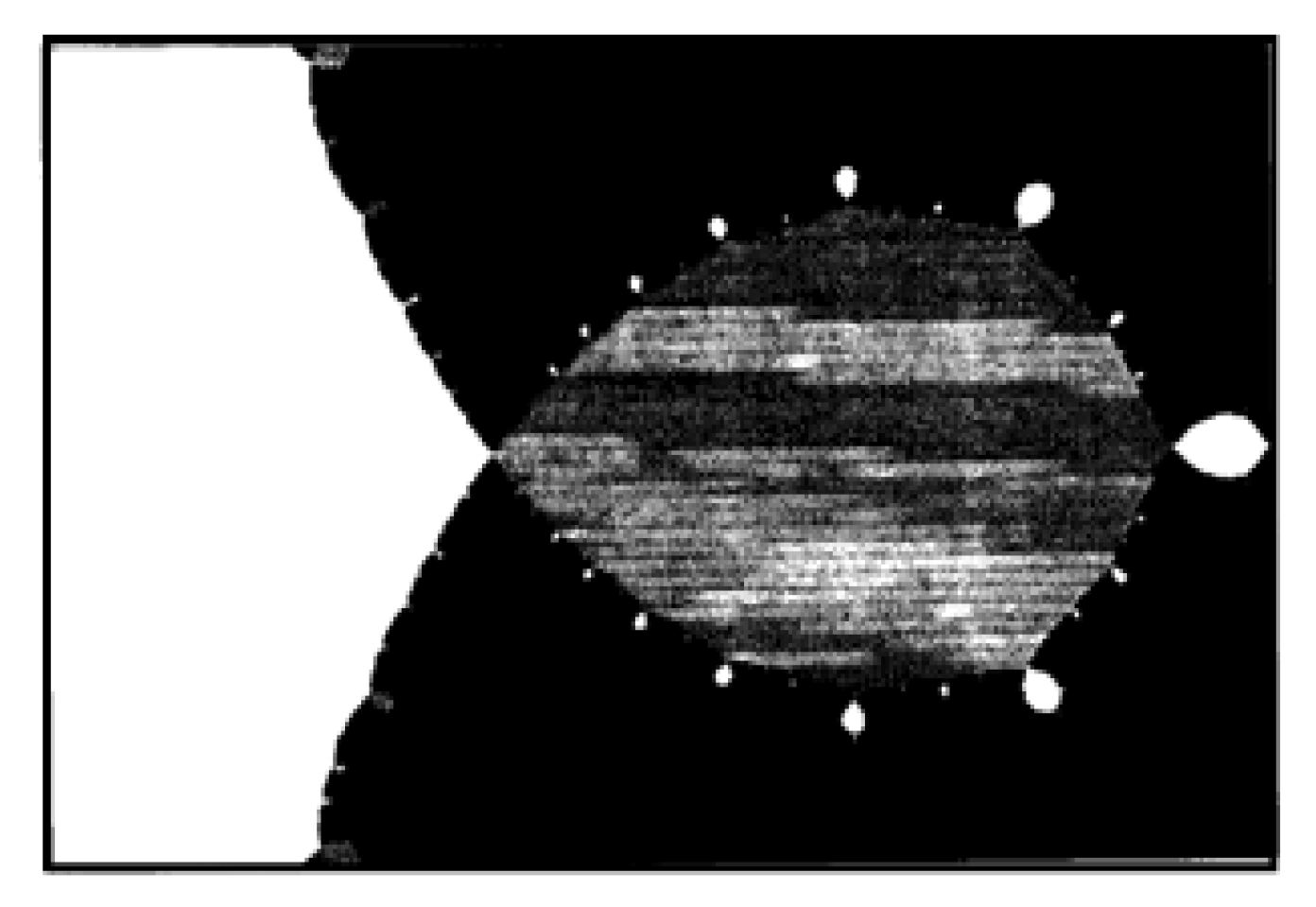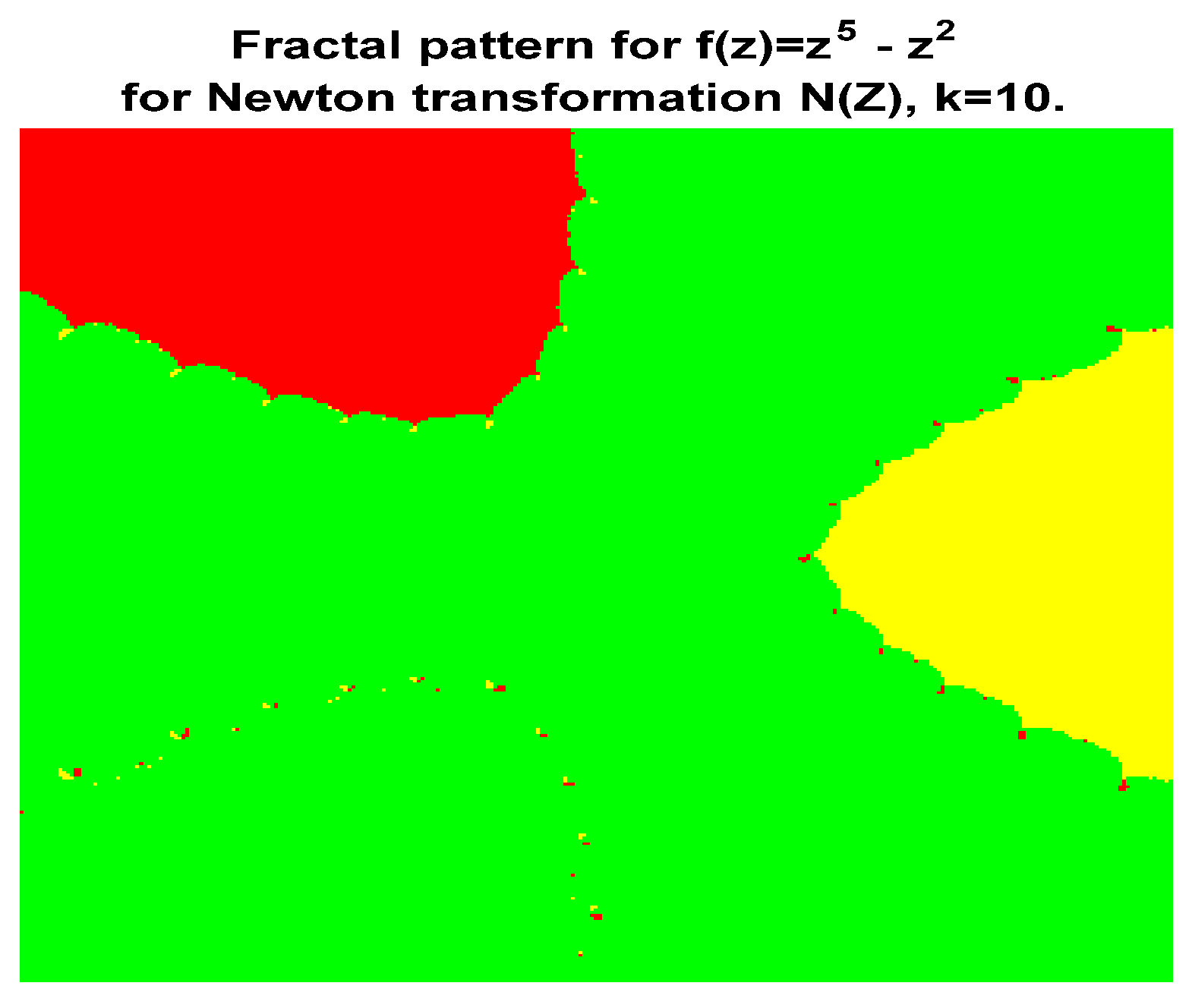Fractals Generated via Numerical Iteration Method
Abstract
:1. Introduction
2. Materials and Methods
2.1. A Numerical Iterative Method in the Complex Plane
2.2. Algorithm for Generating a Fractal Pattern Using a Numerical Iterative Method
2.2.1. The Escape Time Algorithm (Pseudo-Code)
| Algorithm 1: The escape time algorithm |
|
is the iteration count is the escape–radius Represent the complex variable as a couple of real variables in the complex plane and evaluate each point (square grid): loop (forever) is the absolute value of if (modulus>e-radius) then L1: colour-value = n mod colormap; L2: plot pixel; if (n>maxiter) then goto L1, L2; end; % end the loop |
2.2.2. The Modified Escape Time Algorithm
| Algorithm 2: The modified escape time algorithm |
| The Pseudo-code of the algorithm is as follows: % k is the cycle count Represent the complex variable z as a couple of real variables in the complex plane, and evaluate each point on a square mesh grid (mesh grid or region). for n = 1 to cycount do % for loop % numerical iteration formulaend end; % end for loop % computes the absolute value of zn Determine colour-value to the various “basins of attraction”. Plot pixel of modulus with colour-value. |
3. Results
4. Discussion
5. Conclusions
Author Contributions
Funding
Institutional Review Board Statement
Informed Consent Statement
Data Availability Statement
Acknowledgments
Conflicts of Interest
Appendix A

References
- Mandelbrot, B.B. The Fractal Geometry of Nature; W.H. Freeman & Company: New York, NY, USA, 1999. [Google Scholar]
- Falconer, K. Fractal Geometry-Mathematical Foundations and Applications; John Wiley & Sons Ltd.: Hoboken, NJ, USA, 1999. [Google Scholar]
- Gilbert, W.J. Newton’s method for multiple roots. J. Comput. Graph. 1994, 18, 227–229. [Google Scholar] [CrossRef]
- Mathews, J.H.; Fink, K.D. Numerical Methods Using Matlab; Prentice-Hall: Hoboken, NJ, USA, 1999. [Google Scholar]
- Al-shameri, W.F.H. Approximating Lyapunov exponents of a discrete dynamical system. Nanosci. Nanotechnol. Lett. 2019, 11, 1612–1615. [Google Scholar] [CrossRef]
- Al-shameri, W.F.H. A revised algorithm that generates Julia sets using Newton’s method. SUJST 2004, 1, 55–63. [Google Scholar]
- Al-shameri, W.F.H. Deterministic algorithm for constructing fractal attractors of iterated function systems. Eur. J. Sci. Res. 2015, 134, 121–131. [Google Scholar]
- Al-shameri, W.F.H. On Nonlinear Iterated Function Systems. Ph.D. Thesis, University of Al-Mustansiriyah, Baghdad, Iraq, 2001. [Google Scholar]
- Barnsley, M.F. Fractals Everywhere, 2nd ed.; revised with the assistance of and a foreword by Hawley Rising, III; Academic Press: Boston, MA, USA, 1993. [Google Scholar]
- Al-shameri, W.F.H. Existence of the attractor of a recurrent iterated function system. J. Eng. Appl. Sci. 2019, 14, 182–187. [Google Scholar]
- Devaney, R.L. Introduction to Chaotic Dynamical Systems; Addison-Wesley: Menlo Park, CA, USA, 1989. [Google Scholar]
- Gulick, D. Encounters with Chaos; McGraw-Hill: New York, NY, USA, 1992. [Google Scholar]
- Norton, A. The Julia sets in the quarternions. Comp. Graph. 1989, 13, 267–287. [Google Scholar] [CrossRef]
- Scheinerman, R.E. Invitation to a Dynamical System; Department of Mathematical Sciences, the Johos Hopkins University: Baltimore, MD, USA, 2000. [Google Scholar]
- Sprott, J.C.; Pickover, C.A. Automatic generation of general quadratic map basins. J. Comput. Graph. 1995, 19, 309–313. [Google Scholar] [CrossRef]
- Hahn, B.D.; Valentine, D.T. Essential Matlab for Engineers and Scientists; Elsevier Ltd.: Amsterdam, The Netherlands, 2019. [Google Scholar]
- He, C.-H.; Liu, C. A modified frequency-amplitude formulation for fractal vibration systems. Fractals 2021, 25, 463. [Google Scholar] [CrossRef]
- Zuo, Y.-T.; Liu, H.-J. Fractal approach to mechanical and electrical properties of graphene/sic composites. Facta Univ.-Ser. Mech. Eng. 2021, 19, 271–284. [Google Scholar] [CrossRef]
- Liu, F.; Zhang, T.; He, C.-H.; Tian, D. Thermal oscillation arising in a heat shock of a porous hierarchy and its application. Facta Univ. Ser. Mech. Eng. 2021, 19, 4. Available online: http://casopisi.junis.ni.ac.rs/index.php/FUMechEng/article/view/7573 (accessed on 20 January 2022). [CrossRef]




Publisher’s Note: MDPI stays neutral with regard to jurisdictional claims in published maps and institutional affiliations. |
© 2022 by the authors. Licensee MDPI, Basel, Switzerland. This article is an open access article distributed under the terms and conditions of the Creative Commons Attribution (CC BY) license (https://creativecommons.org/licenses/by/4.0/).
Share and Cite
Al-shameri, W.F.H.; El Sayed, M. Fractals Generated via Numerical Iteration Method. Fractal Fract. 2022, 6, 196. https://doi.org/10.3390/fractalfract6040196
Al-shameri WFH, El Sayed M. Fractals Generated via Numerical Iteration Method. Fractal and Fractional. 2022; 6(4):196. https://doi.org/10.3390/fractalfract6040196
Chicago/Turabian StyleAl-shameri, Wadia Faid Hassan, and Mohamed El Sayed. 2022. "Fractals Generated via Numerical Iteration Method" Fractal and Fractional 6, no. 4: 196. https://doi.org/10.3390/fractalfract6040196
APA StyleAl-shameri, W. F. H., & El Sayed, M. (2022). Fractals Generated via Numerical Iteration Method. Fractal and Fractional, 6(4), 196. https://doi.org/10.3390/fractalfract6040196





